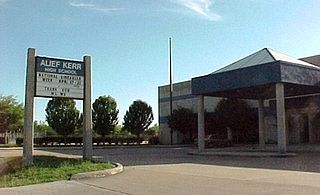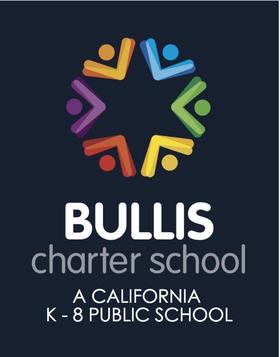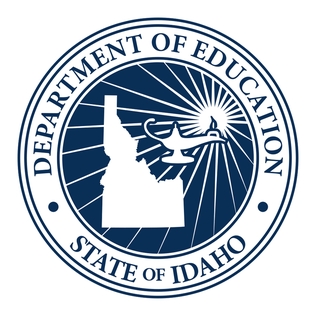
The No Child Left Behind Act of 2001 (NCLB) was a U.S. Act of Congress that reauthorized the Elementary and Secondary Education Act; it included Title I provisions applying to disadvantaged students. It supported standards-based education reform based on the premise that setting high standards and establishing measurable goals could improve individual outcomes in education. The Act required states to develop assessments in basic skills. To receive federal school funding, states had to give these assessments to all students at select grade levels.
The Academic Performance Index (API) was a measurement of academic performance and progress of individual schools in California, United States. The API was one of the main components of the Public Schools Accountability Act passed by the California State Legislature in 1999. It was last updated for the 2012–2013 school year, an on March 15, 2017, the California State Board of Education and the California Department of Education launched a new accountability system to replace the Academic Performance Index to better measure California's education goals. The replacement reporting interface is the California School Dashboard.
Cleveland Metropolitan School District, formerly the Cleveland Municipal School District, is a public school district in the U.S. state of Ohio that serves almost all of the city of Cleveland. The district covers 79 square miles. The Cleveland district is the second largest PreK-12 district in the state, with a 2017–2018 enrollment of about 38,949. CMSD has 68 schools that are for kindergarten to eighth grade students and 39 schools for high school aged students.

Gretchen A. Whitney High School, called Whitney High School or WHS, is a public school in Cerritos, California serving grades 7–12. It is in the ABC Unified School District. According to US News Report, as of 2022, Whitney High School is ranked 1st in the state of California and ranked 14th nationally among all high schools.

Alief Kerr High School is an Alief ISD public school located in the Alief community, and in the limited purpose city limits of Houston, Texas, United States. The school is a part of the Alief Independent School District and serves grades 9 through 12.
Piedmont Hills High School is a comprehensive public four-year high school located in the Berryessa neighborhood of San Jose, California, USA. It is part of the East Side Union High School District and in 2019 was ranked in the highest categories on the California School Dashboard, earning the top rating of "blue" for Mathematics, English Language Arts, and Graduation Rate. In 2003, it was awarded a California Distinguished School recognition and has received various awards in several aspects of its curriculum since. Together with Independence High School and Yerba Buena High School, Piedmont Hills is one of a few schools in the district to have retained its own music program.
Adequate Yearly Progress (AYP) is a measurement defined by the United States federal No Child Left Behind Act that allows the U.S. Department of Education to determine how every public school and school district in the country is performing academically according to results on standardized tests. As defined by National Council on Measurement in Education (NCME), AYP is "the amount of annual achievement growth to be expected by students in a particular school, district, or state in the U.S. federal accountability system, No Child Left Behind (NCLB)." AYP has been identified as one of the sources of controversy surrounding George W. Bush administration's Elementary and Secondary Education Act. Private schools are not required to make AYP.
The California Assessment of Student Performance and Progress (CAASPP), known until February 2014 as the Measurement of Academic Performance and Progress (MAPP), measures the performance of students undergoing primary and secondary education in California. In October 2013, it replaced the Standardized Testing and Reporting (STAR) Program.

Bullis Charter School (BCS) is a public charter school in Los Altos, California, USA, for grades kindergarten through eighth. As the Santa Clara County Office of Education charters the school, BCS operates independently of the Los Altos School District (LASD). BCS provides full-time teaching specialists in the arts and sciences, a Mandarin language program, and optional after-school activities. The school is funded in approximately equal parts from state funding and parent donations.

The New York State Education Department (NYSED) is the department of the New York state government responsible for the supervision for all public schools in New York and all standardized testing, as well as the production and administration of state tests and Regents Examinations. In addition, the State Education Department oversees higher education, cultural institutions such as museums and libraries, vocational rehabilitation, and the licensing of numerous professions. It is headed by the Board of Regents of the University of the State of New York (USNY) and administered by the Commissioner of Education.
Richmond High School (RHS) is a secondary school located in Richmond, California, United States. It is part of the West Contra Costa Unified School District (WCCUSD) and serves half of North Richmond and San Pablo.
Midway Independent School District is a public school district based in Woodway, Texas, USA.
The State of Kuwait, located at the head of the Persian Gulf, supports an educational policy that seeks to provide an opportunity to all children, irrespective of their social class, including children with special needs. Kuwait was ranked 63rd on the Human Development Index report for 2011 by the United Nations Development Programme, placing Kuwait above the regional average.
San Leandro Unified School District is a publicly funded unified school district in San Leandro, Alameda County, California on the eastern shore of San Francisco Bay, between Oakland to the northwest and Hayward to the southeast. The district has 12 schools and 447 teachers, with a total enrollment of 8,729 students in kindergarten through 12th grade.
The Rhode Island Department of Education (RIDE) is a state agency in Rhode Island that oversees the elementary and secondary education system from pre-Kindergarten through high school. It is headquartered in Providence. RIDE works closely with the Rhode Island Office of the Postsecondary Commissioner (RIOPC), the agency charged with overseeing higher education. Together, RIDE and RIOPC aim to provide an aligned, cohesive, and comprehensive education for all students.

The Arkansas Department of Education (ADE) is a cabinet-level agency of the Arkansas state government overseeing public education for K-12, higher education institutions, and career and technical education.

The Idaho State Department of Education is an executive agency of the Idaho state education system. The department is responsible for public elementary and secondary school matters as provided by Title 33, Idaho Code, or as determined by the Idaho State Board of Education. It is headquartered in the state capital, Boise, Idaho.

Centennial High School is a public high school in Compton, California, part of the Los Angeles metropolitan area.
In Louisiana, the Minimum Foundation Program is the formula that determines the cost to educate students at public elementary and secondary schools and defines state and local funding contributions to each district. Education officials often use the term "MFP" to refer specifically to the portion the state pays per student to each school district.

The Every Student Succeeds Act (ESSA) is a US law passed in December 2015 that governs the United States K–12 public education policy. The law replaced its predecessor, the No Child Left Behind Act (NCLB), and modified but did not eliminate provisions relating to the periodic standardized tests given to students. Like the No Child Left Behind Act, ESSA is a reauthorization of the 1965 Elementary and Secondary Education Act, which established the federal government's expanded role in public education.








